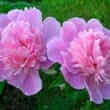Background
- Peony root has been used in traditional Chinese medicine (TCM) for centuries. Peony flowers are also used medicinally, for example, in cough syrups and in herbal teas. In combination with other herbs, peony has been used to treat a wide variety of health conditions, including menstrual problems, kidney problems, pulmonary heart disease, uterine fibroids, and pneumonia. Peony has been applied to the skin to prevent wrinkles and has been taken by mouth to treat pulmonary heart disease and liver problems caused by chronic hepatitis.
- There is good scientific evidence of an effect of peony in the treatment of pulmonary heart disease. There is also a growing body of research on TCM formulas containing peony for women's health conditions including menstrual problems, uterine fibroids, hormone regulation, and heart disease prevention. Higher quality studies are needed before a firm recommendation can be made.
References
- Guo D, Ye G, Guo H. A new phenolic glycoside from Paeonia lactiflora. Fitoterapia 2006;77(7-8):613-614.
View Abstract - Kang JH, Park YH, Choi SW, et al. Resveratrol derivatives potently induce apoptosis in human promyelocytic leukemia cells. Exp Mol Med 12-31-2003;35(6):467-474.
View Abstract - Kang DG, Moon MK, Choi DH, et al. Vasodilatory and anti-inflammatory effects of the 1,2,3,4,6-penta-O-galloyl-beta-D-glucose (PGG) via a nitric oxide-cGMP pathway. Eur J Pharmacol 11-7-2005;524(1-3):111-119.
View Abstract - Kim HJ, Chang EJ, Bae SJ, et al. Cytotoxic and antimutagenic stilbenes from seeds of Paeonia lactiflora. Arch Pharm Res 2002;25(3):293-299.
View Abstract - Kim HJ, Chang EJ, Cho SH, et al. Antioxidative activity of resveratrol and its derivatives isolated from seeds of Paeonia lactiflora. Biosci Biotechnol Biochem. 2002;66(9):1990-1993.
View Abstract - Lee SM, Li ML, Tse YC, et al. Paeoniae Radix, a Chinese herbal extract, inhibit hepatoma cells growth by inducing apoptosis in a p53 independent pathway. Life Sci 9-27-2002;71(19):2267-2277.
View Abstract - Lee S, Lim JM, Jin MH, et al. Partially purified paeoniflorin exerts protective effects on UV-induced DNA damage and reduces facial wrinkles in human skin. J Cosmet Sci 2006;57(1):57-64.
View Abstract - Leem K, Kim H, Boo Y, et al. Effects of Paeonia lactiflora root extracts on the secretions of monocyte chemotactic protein-1 and -3 in human nasal fibroblasts. Phytother Res 2004;18(3):241-243.
View Abstract - Nishida S, Kikuichi S, Yoshioka S, et al. Induction of apoptosis in HL-60 cells treated with medicinal herbs. Am J Chin Med 2003;31(4):551-562.
View Abstract - Oh GS, Pae HO, Choi BM, et al. Inhibitory effects of the root cortex of Paeonia suffruticosa on interleukin-8 and macrophage chemoattractant protein-1 secretions in U937 cells. J Ethnopharmacol. 2003;84(1):85-89.
View Abstract - Prieto JM, Recio MC, Giner RM, et al. Influence of traditional Chinese anti-inflammatory medicinal plants on leukocyte and platelet functions. J Pharm Pharmacol. 2003;55(9):1275-1282.
View Abstract - Shen AY, Wang TS, Huang MH, et al. Antioxidant and antiplatelet effects of dang-gui-shao-yao-san on human blood cells. Am J Chin Med 2005;33(5):747-758.
View Abstract - Stavri M, Mathew KT, Bucar F, et al. Pangelin, an antimycobacterial coumarin from Ducrosia anethifolia. Planta Med 2003;69(10):956-959.
View Abstract - Sun WS, Imai A, Tagami K, et al. In vitro stimulation of granulosa cells by a combination of different active ingredients of unkei-to. Am J Chin Med 2004;32(4):569-578.
View Abstract - Wong AL, Chan TY. Interaction between warfarin and the herbal product quilinggao. Ann Pharmacother 2003;37(6):836-838.
View Abstract







